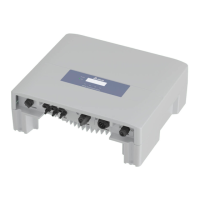5 Planning the installation
Installation and Operation Manual for RPI M6A M8A M10A inverters V1.0 2016-02-03
26
5.7 AC connection
Always adhere to the specic regulations applicable in your coun-
try or region.
Always adhere to the specic regulations dened by your grid
operator.
For the safety of the user and for the security of your installation,
install required safety and protection devices that are applicable
for your installation environment (example: automatic circuit
breaker and/or overcurrent protection equipment).
2
Use the proper upstream circuit breaker to protect the inverter:
Model Upstream Circuit Breaker
RPI M6A 16 A
RPI M8A 16 A
RPI M10A 20 A
N
L1
L2
L3
PE
to the
inverter
Fig. 5.11: Position of upstream circuit breaker
Due to its design, the inverter is not capable of feeding DC resid-
ual current back into the grid. It fulls this requirement in accor-
dance with DIN VDE 0100-712.
When examining these possible fault situations in terms of the
currently valid installation standards, Delta has come to the
conclusion that there is no danger when operating the inverter
in combination with a type A upstream residual-current device
(RCD).
Therefore faults that would otherwise require the use of a type B
residual-current device due to the inverter can be excluded.
The integrated all-pole sensitive RCMU is certied according
to VDE 0126 1-1/A1:2012-02 §6.6.2 for a tripping current of
300 mA. RCD Type A can be used for this inverter, according to
the following table.
Minimum tripping current of the RCD ≥100 mA
NOTE
The value of the tripping current mainly depends
on the quality of the solar modules, the size of
the PV array and environmental conditions (e.g.
humidity). The tripping current of the residual
current device must not be less than the speci-
ed minimum tripping current.
Permitted earthing systems
Earthing
System
TN-S TN-C TN-C-S TT IT
Permitted Yes Yes Yes Yes No
AC grid voltage requirements
3P3W Voltage 3P4W Voltage
L1-L2 400 V
AC
± 20% L1-N 230 V
AC
± 20%
L1-L3 400 V
AC
± 20% L2-N 230 V
AC
± 20%
L2-L3 400 V
AC
± 20% L3-N 230 V
AC
± 20%

